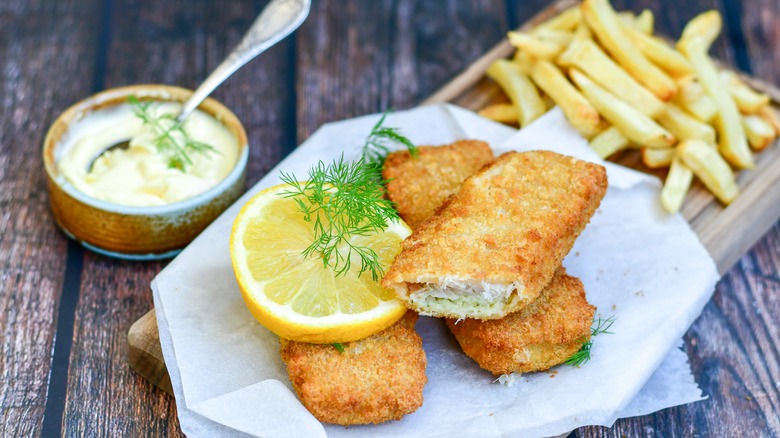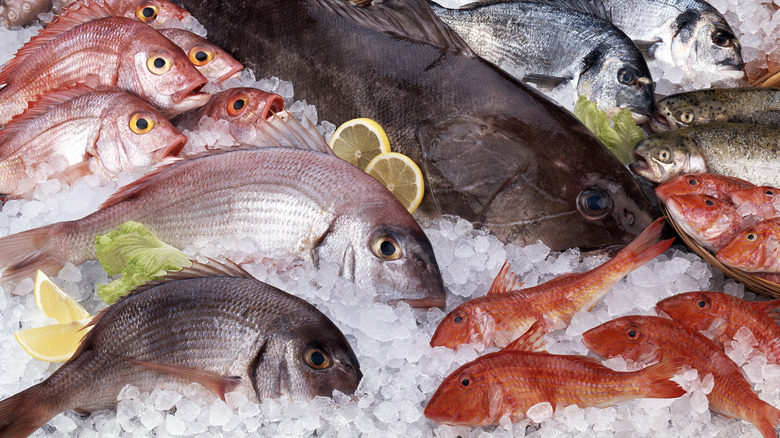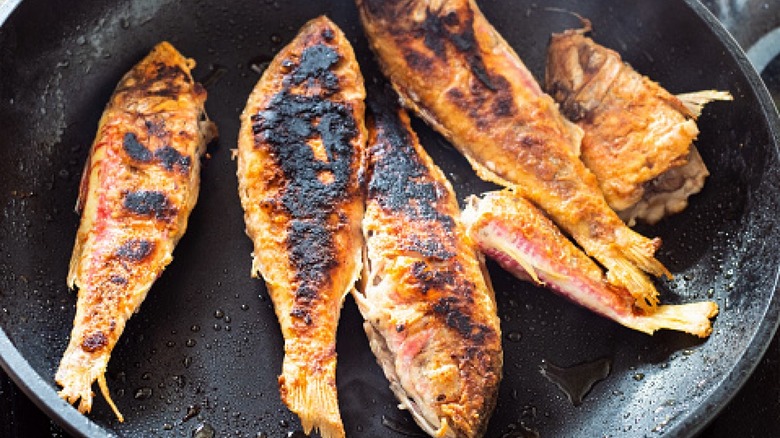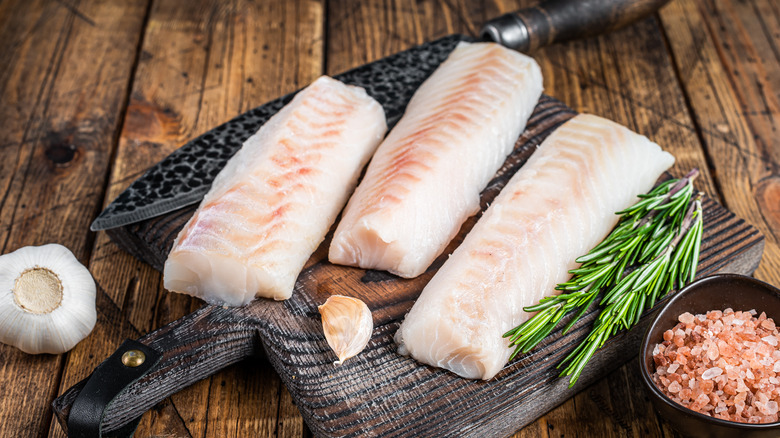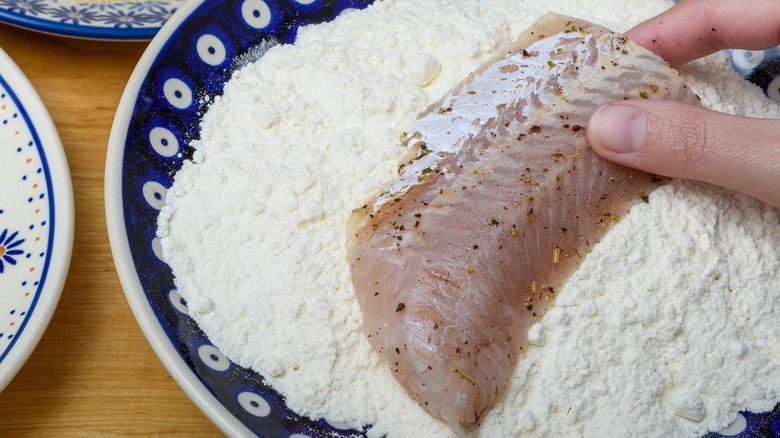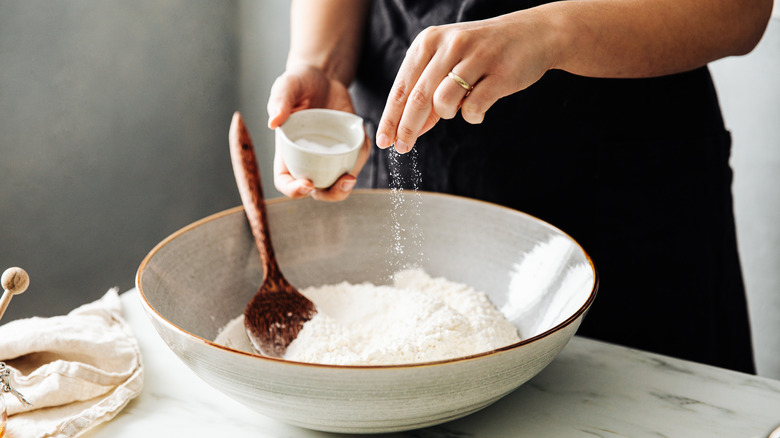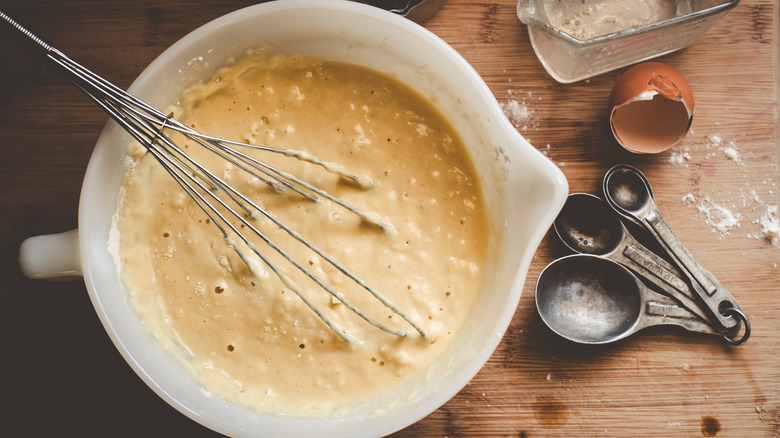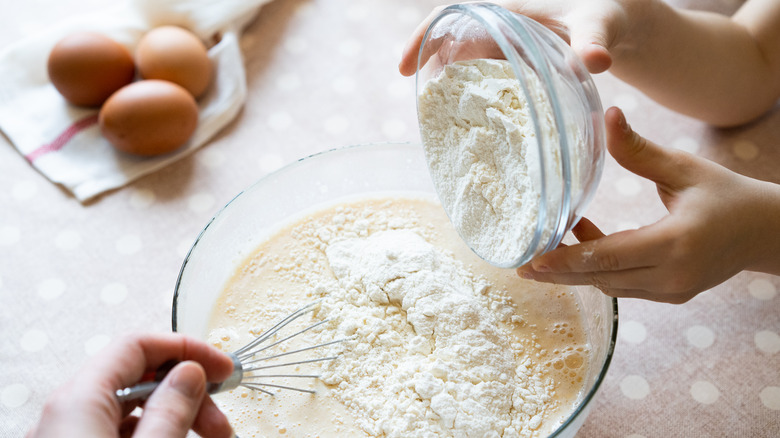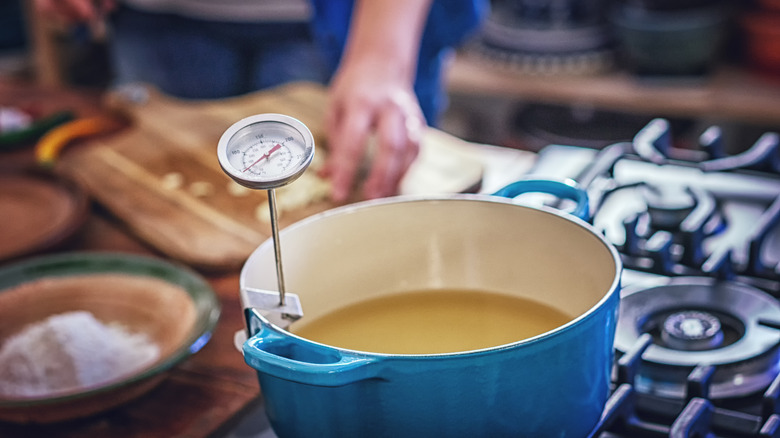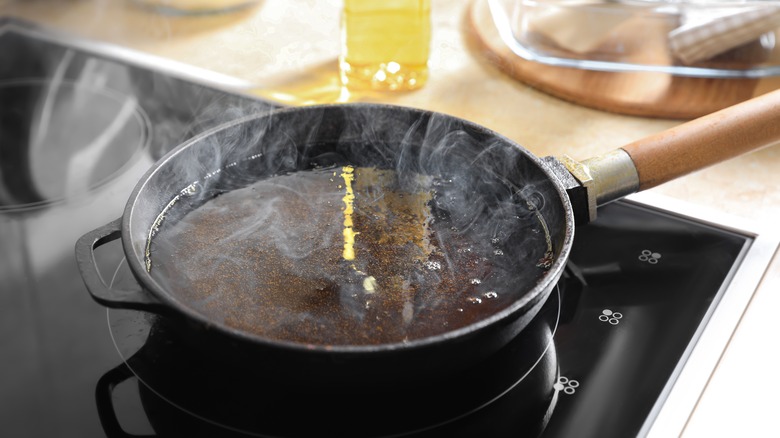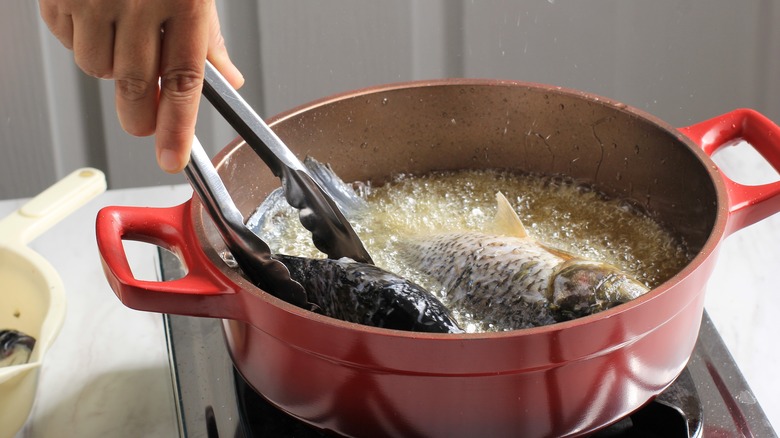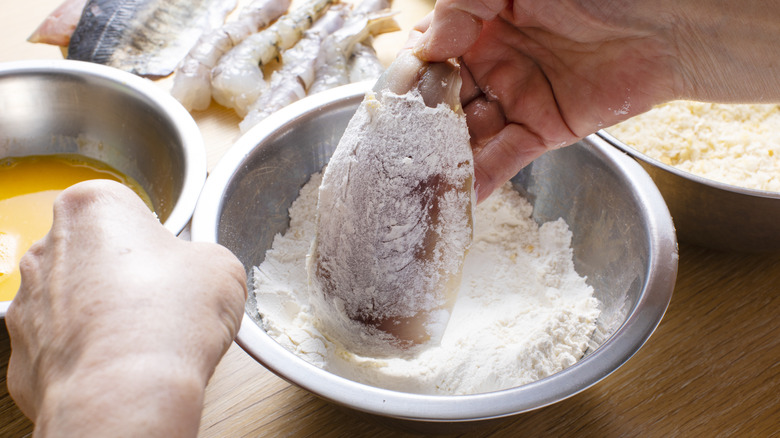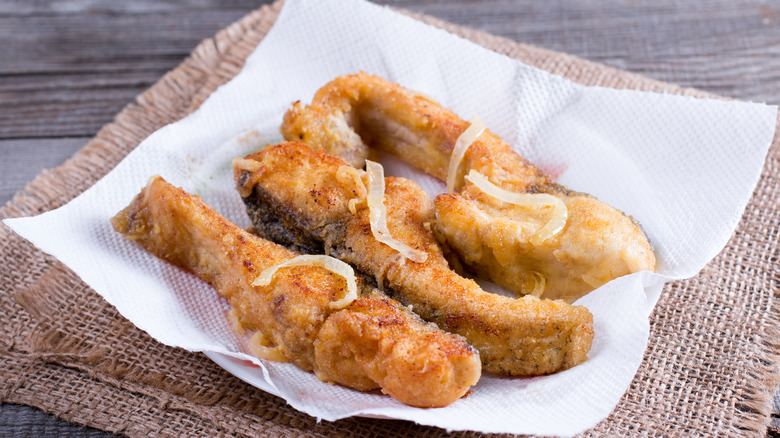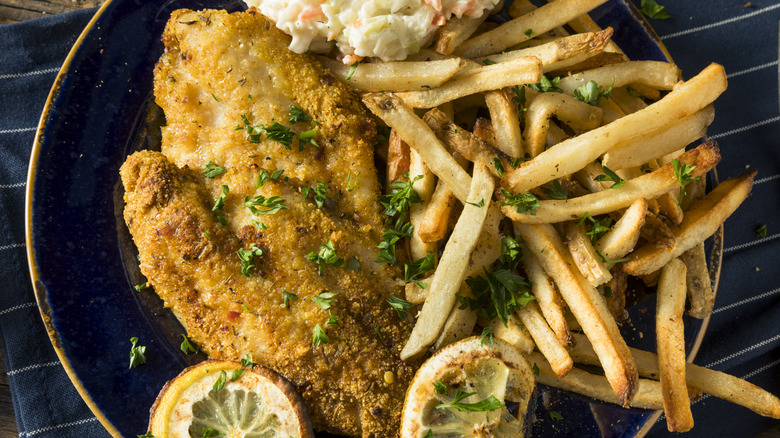13 Big Mistakes Chefs Say Everyone Makes When Deep Frying Fish
Besides fried chicken, fish is our favorite protein to cook in copious amounts of sizzling oil. This relatively lean protein is tender, flaky, and moist and finds an ideal partner in a crunchy crust. Besides being delicious, it is also relatively affordable. Deep-fried fish is something we often eat out, but many love to recreate the delicious dish at home. Though the preparation is not overly demanding, there are many mistakes home cooks make in the process, resulting in dry, chewy fish coated in a sad, soggy crust. To avoid these disappointing combinations, it's crucial to identify the most common mistakes and not repeat them in the future. To help you with this, we've assembled them in one place, and we called our experts to weigh in and offer their opinion.
We talked to Chef Dennis Littley, who has gone through traditional culinary education and has spent over 40 years in restaurant kitchens. He aims to familiarize home cooks with restaurant-style dishes and teach them how to easily recreate them at home. We've also interviewed Colin Bauman, the kitchen manager at the legendary Dexter's Pub in Madison, Wisconsin that serves an award-winning fish fry on Fridays. Not only did the experts help us identify the problems, but they also offered practical advice on how to prevent these mistakes from happening.
1. Choosing the wrong type of fish
One of the biggest mistakes people make when frying fish happens at the very beginning when choosing the right fish. As there are so many available varieties, it can sometimes be overwhelming to find the one best fit for frying. Some are too delicate and can't go through the whole batter and fry process without falling apart, while others are too firm and can't benefit from frying. Our experts shared their advice on the topic, listing the foolproof options as well as personal favorites.
Dennis Littley is a fan of white fish fillets. Flounder and catfish are some of his favorites, though he claims they tend to be finicky to fry as they are tender and break easily. He highlights grouper and cod as perhaps the best choices that hold shape and attain a beautiful coating. As they are usually thicker, the fillets don't dry out in the process. They preserve moisture and remain juicy. Littley reflected on not so preferable choices, claiming that thick "steak types of fish, like tuna or swordfish, are denser and tend to be drier, and aren't good choices for frying."
Colin Bauman emphasizes cod as the Midwest favorite. Cod is equally loved by his guests, as he claims that the restaurant goes "through hundreds of pounds a month." He also mentions pollock and petrale as his personal favorites and states that thinner fillets are his choice as the batter also gets the chance to shine.
2. You are overcooking it
Another common mistake people make with fried fish is overcooking it. Though we are now familiar with eating sushi and all its variants, this mistake probably stems from the unfounded fear of eating raw, undercooked fish. As most fish are very sensitive to heat, leaving your battered fillets in sizzling oil for too long will result in dry and crumbly fillets. It will most likely end up coated in an unappealing dark crust, possibly followed by an unpleasant burnt-like aftertaste.
Colin Bauman weighed on the topic, claiming that this is perhaps the most common mistake people make when frying fish. He said that, "Fish cooks really quickly, especially if you're only doing a dry dredge." Though it's important to consider the thickness and the type of dredge, Bauman also emphasized that "beer-battered cod will take longer, but still should be done in less than 10 minutes."
If you're not sure when the fish is ready, Bauman suggests using a thermometer. "At the restaurant, we use thermometers to make sure that the fish hits 145 Fahrenheit internal." For home chefs and those who do not own a thermometer, he suggests the straightforward option of breaking a piece to see if it's cooked. "If it's soft and flaky and cooked through, you're there." Sacrificing one piece of fish to avoid dry fish and burnt crust is definitely worth it.
3. Believing that the quality of the fish does not matter
Many wrongly assume that frying can mask old or bad-flavored fish, but the truth is that the most important prerequisite for great fried fish is starting with the best-quality material, as frying can only accentuate its quality. Usually, this means you are using the freshest possible fish you can find. Fresh fish fillets will be juicy, firm, and springy to the touch, which means that they won't break apart or dry out in the process.
As fresh fish is often difficult to find if you don't have a fishmonger you can absolutely trust, Colin Bauman suggests frozen fish as a great alternative. He highlights that frozen fish will work great "as long as it's been treated well." He explains that the ideal scenario includes freezing fish on the boat immediately as it's pulled out of the sea. This means that all those good qualities of fresh fish will be preserved. He also informed us that, "Reputable companies will have on the packaging where and when it was caught." This is a great way to be sure that your fish comes from a reliable source that has been caught and frozen correctly. Bauman also highlights that you should never refreeze frozen fish and recommends using it "asap or the texture degrades fairly quickly."
4. Skipping the dredge that will help the batter stick
Broadly speaking, fish can be prepped for frying with a classic flour-based dry dredge or using a wet, egg-based batter. The choice of which technique to use mainly depends on the type of fish. Chef Colin Bauman explained that he prefers, "Wet batter for meaty whitefish like cod and pollock, while a simple seasoned flour works better for smaller fish like perch, bluegill, smelt, etc.," Regardless of the preferred technique, there are many mistakes that can be made in the process, and one of the most common ones is skipping the flour dredge before you coat the fish in wet batter.
"Coating the fish with flour before adding it to the batter will help the batter stick to the fish. The flour gives the batter a surface to adhere to," explained Dennis Littley." This simple step in the frying process will prevent a disappointing situation when the crunchy batter simply slides off the fillet and ruins the whole experience. This is one mistake that is easy to prevent, so next time, lightly coat the fillet in flour and let it act as a seal that will keep that crunchy coating in place.
5. You don't take advantage of all seasoning possibilities
Fish is an attractive protein as it has a relatively neutral flavor that allows you to play with spices and seasonings. On the other hand, if you miss to season it properly, it often results in a bland and boring meal. As frying is such a powerful and robust technique, you want to season the fish well so the flavor does not get lost in the process. This is where many people make a mistake. By being modest with the spices, they overlook many seasoning possibilities.
"Seasoning the fish with salt and black pepper before dredging it in flour is an easy way to season it before cooking," explained Dennis Littley. But he also thinks seasoning the flour before dredging the fish is a great idea. Chef Colin Bauman also supports the technique of adding seasoning to flour and the batter. He shares that his favorite blend includes "paprika, cayenne, garlic powder, black pepper, onion powder, dry parsley, and plenty of salt." His preferred technique is to grind all the spices together "to get them fine enough to mix well into flour."
Chef Littley also suggested a neat trick of adding hot sauce to the batter to get even more flavor in the crust, while Bauman recommended amber or red ale as the best choice for the perfect beer batter. He also shared an additional tip saying: "Don't cook with beer you wouldn't enjoy drinking."
6. Not giving your batter time to rest before using it
Though dry dredge has its advantages and might be better suited for some fish varieties, the wet batter also has a lot of loyal fans. The batter is usually simple, typically assembled with flour, seasonings, and water, though beer is a great bubbly alternative. Though there are many variations and styles, the result is mainly a runny batter that thoroughly coats the fish. In an ideal scenario, when fried, you want to get an equally browned and perfectly crispy shell. Though the technique is seemingly straightforward, there are many opportunities to mess things up, and one of them is not leaving the batter to rest before using it.
Chef Colin Bauman suggests the technique of leaving the batter on the counter for at least half an hour. He explained that "this gives the flour time to fully hydrate and allows some of the bubbles to dissipate." He clarified that rested batter is generally better at adhering to the fish, which prevents the coating from slipping off the fillet after frying. It is also much easier to achieve the right consistency with rested batter. He explained that as you fry, the batter you whipped up fresh "will get thicker and thicker, leading to the last batch of fish being very different from the first."
7. Overmixing your batter
Overmixing is another mistake that relates to the wet batter technique. This usually happens as we're too eager to make a homogenous blend that we keep mixing long after the ingredients have been blended. The problem with overmixing is gluten, the firm protein network that gives bread and cakes their springy texture. Though gluten is welcomed in most baked goods, you want to avoid it when making a batter intended for frying. Gluten develops with kneading or mixing and creates strong bonds that prevent the batter from attaining crispiness during frying. There is also the infamous tendency to soak up more oil, resulting in a soft and mushy coating. Of course, this only applies if you're using wheat or any other gluten-laden flour in your batter.
Though you don't want to overmix the batter, you also don't want to have lumps and dry patches that will burn during frying. Make sure to mix the batter thoroughly but stop mixing once it achieves uniform consistency. Chef Dennis Littley suggests using a whisk as the best tool to avoid lumps, and he also says that it's best to "use a rubber spatula to scrape the sides and bottom of the bowl to release any flour that might have stuck." This system will ensure that everything is done quickly and efficiently.
8. Your oil is not hot enough
Our experts agree that cooking with oil that is not hot enough is the biggest mistake people make when deep-frying fish. Dennis Littley explains that regardless of which frying vessel you're using, "The oil needs to be between 350 and 365 degrees." He argues this is the only way to ensure that you end up with a crispy crust while keeping the fish moist and juicy. Colin Bauman agrees, saying that 350 degrees Fahrenheit is the golden standard, though he claims you can slightly go overboard when frying at home. As the temperature drops when you add the fish to sizzling oil, starting with the slightly higher temperature "gives the fish more cooking time in the golden zone."
You can't really eyeball the temperature, so our chefs recommend using an instant-read thermometer. Check the temperature before putting the fish in the oil, but Bauman also suggests keeping the thermometer inside the oil throughout the whole process. This helps you monitor temperature, making sure it never drops below 300 degrees Fahrenheit so you can amp up the heat and get it to that ideal temperature quickly. The oil temperature is so crucial that Bauman suggests waiting between batches to ensure the temperature is perfect.
9. You don't use enough oil
Besides the temperature of the oil, when you're trying to deep-fry at home, it's equally important to ensure that the amount of oil is on point. Too much oil is rarely a problem, but deep-frying in shallow oil could result in a culinary catastrophe, leaving you with a mushy coating that can't achieve that perfect crunch.
Chef Dennis Littley mentions this mistake as one of the common among home cooks. "Cooking in insufficient oil will result in soggy, oily fish," Littley claims. To prevent this from happening, if you're not using the fryer, you first need to use a dish with enough depth to hold all that oil. When adding the oil, make sure that you have enough so that when you drop your fillets inside, they can float and expand without coming in contact with the bottom of the dish. On the other hand, you need to be careful not to fill your frying pot to the brim. When you add the fish, the oil will sizzle, and tiny bubbles will pop up, so you want to leave room for them to bubble away without going over the edge of the dish. If you don't own a fryer, it's best to go with a heavy cast iron Dutch oven as it is usually deep enough and retains temperature well.
10. Overcrowding the pan
Regardless of which cooking vessel you choose for deep-frying fish, it's crucial not to overcrowd it. This is one of the general rules you should follow when cooking with oil, regardless if you're using a wok, pan-frying, or even roasting food on a sheet pan. Overcrowding usually ends with the same results: your protein won't caramelize, and the veggies will remain soft and mushy.
When deep-frying fish, Chef Dennis Littley claims that packing too many pieces in one go "can result in a soggy fish." The reason why this happens relates to the temperature of the oil. As Littley explains, dropping too many pieces into the sizzling oil will immediately decrease the temperature, and your fish will soak up more oil than it should. To prevent this from happening, make sure to cook in batches. It's always better to extend the cooking time rather than to deal with a disappointing, overly oily fish that misses on that distinctive crunch.
11. Not using the prepared flour mix
Not using a pre-packed flour mix is not a mistake that will ruin deep-fried fish, but it can make your life much easier and help to amp up crispiness. It is also a great way to maintain consistency.
Colin Bauman points out that these mixes often include "things like milk powder, cornmeal, baking soda that will all help you get a better end result." Ingredients such as cornmeal and baking soda or baking powder have become classic additions inside batter and dredge intended for frying. Baking powder and baking soda create tiny air pockets in contact with oil, which creates crispy breading that is easy to break into. Cornmeal is another classic trick that helps to create a crispier coating with more character and flavor.
These mixes don't pack unusual ingredients, and as Bauman explains, it's fairly easy to recreate this bread mix at home. However, he also argues that, "If you can get a better product with less work why not try it."
12. Not resting the fish properly after frying
When you pull out those golden-colored chunks from the sizzling oil, you probably think nothing can go wrong at this stage, but you're in for a surprise. What follows is the drain and rest period, which is the make-or-break step that can help your fish keep its skillfully created crisp or turn it into a mushy mess. It's crucial that you let your deep-fried fish drain after it leaves the fryer. The crust will have some oil on the surface that you should get rid of, as it can make the crust soft and mushy. Even if you're frying several batches, Colin Bauman suggests using "a wire rack or plenty of paper towel so it doesn't make itself soggy."
Skipping this step would be a huge mistake, even if you fry everything in one go. This step helps the fish to cook through and all the juices to settle. If you break into it too soon, the juices will immediately run out, leaving you with dry fish. You also want to avoid stacking the pieces on top of each other as they dry and drain. Arrange them in a single layer so that each piece can lose the excess oil properly. Otherwise, all that oil will end up being soaked by the pieces stacked at the bottom.
13. Skipping the seasoning after frying
Once you find the best fish, perfect the batter and the dredge, and learn not to overpack your skillet, you'll probably think that the room for mistake ends here and that you'll finally pull out that perfect version of deep-fried fish. But there is one tiny mistake you're probably making at the very last end — not seasoning your fish after frying.
As we've explained, seasoning is a crucial step when prepping deep-fried fish, but on top of that, you should give your fried fish a boost with some extra seasoning after it leaves the fryer. A sprinkle of salt is sometimes enough to make the dish pop, but you can always play with other options. Besides seasoning, herbs, and spices, the classic squeeze of lemon juice or a sprinkle of lemon zest will instantly brighten the dish. Regardless of which fish you use, Colin Bauman recommends serving it with lemon and malt vinegar, the potently-flavored seasoning that is mandatory with British fish and chips.
